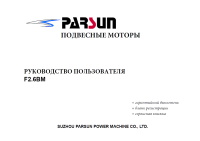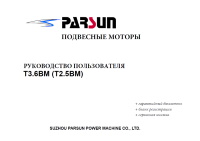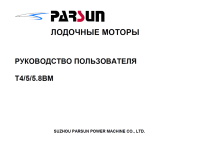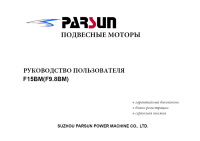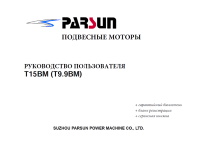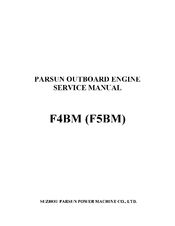- Manuals
- Brands
- Parsun Manuals
- Outboard Motor
- F5BM
- Owner’s manual
-
Bookmarks
Quick Links
OUTBOARD MOTOR
OWNER’S MANUAL
F4BM (F5BM)
SUZHOU PARSUN POWER MACHINE CO., LTD
Related Manuals for Parsun F5BM
Summary of Contents for Parsun F5BM
-
Page 1
OUTBOARD MOTOR OWNER’S MANUAL F4BM (F5BM) SUZHOU PARSUN POWER MACHINE CO., LTD… -
Page 2
If there is any question concerning the manual, please consult your local PARSUN dealer. Data, illustrations or explanations in this Owner’s Manual do not constitute base for any legal claim against our company. -
Page 3
Record your outboard motor serial number in the spaces provided to assist you in ordering spare parts from your PARSUN dealer or for reference in case your outboard motor is stolen. 1. Outboard motor serial number location… -
Page 4
Engine serial number The engine serial number is carved on the aluminum casting of engine. Engine serial number as follows: Manufacturer’s Declaration This outboard motor complies with the requirements of Directive 2003/44/EC in relation to the exhaust and noise emissions. The following installation and maintenance instructions, if applied, guarantee that the outboard motor will remain in compliance with: Exhaust emissions limits throughout the normal life or the engine (350 hours or 10 years, whichever occurs first) and under normal conditions of use. -
Page 5
Table of contents 1. Main components and General information……………………………………………………………1 1.1. Main components………………………………………………………………………………………1 1.2. General information……………………………………………………………………………………3 1.2.1. Specifications………………………………………………………………………………………3 Fueling instructions ………………………………………………………………………………4 1.2.2. 1.2.3. Propeller selection…………………………………………………………………………………5 2. Operation…………………………………………………………………………………………………6 2.1. Installation………………………………………………………………………………………………6 2.1.1 Mounting height……………………………………………………………………………………7 2.1.2 Clamping the outboard motor……………………………………………………………………8 Breaking in engine ……………………………………………………………………………………9 Pre-operation checks…………………………………………………………………………………10 Filling fuel………………………………………………………………………………………………11 Starting engine ………………………………………………………………………………………13… -
Page 6
2.11.1. Tilting up …………………………………………………………………………………………25 2.11.2. Tilting down ……………………………………………………………………………………27 2.12 Cruising in other conditions ………………………………………………………………………29 2.12.1. Cruising in shallow water ………………………………………………………………………29 2.12.2. Cruising in salt water……………………………………………………………………………29 3. Maintenance……………………………………………………………………………………………30 Greasing ……………………………………………………………………………………………30 3.1. Cleaning and adjusting spark plug ………………………………………………………………31 3.2. 3.3. Checking fuel system………………………………………………………………………………31 Inspecting idling speed ……………………………………………………………………………32 3.4. -
Page 7
Transporting and storing outboard motor……………………………………………………………43 Transporting …………………………………………………………………………………………43 4.1. 4.2. Storing………………………………………………………………………………………………44 5. Action in emergency …………………………………………………………………………………52 Impact damage ……………………………………………………………………………………47 5.1. Starter will not operate ……………………………………………………………………………52 5.2. Treatment of submerged motor …………………………………………………………………55 5.3. 6. Troubleshooting ………………………………………………………………………………………57 7. Circuit diagram ………………………………………………………………………………………57… -
Page 8
1. Main components and General information 1.1 Main components 1. Top cowling 8. Clamp bracket 14. Carrying handle 21. Fuel tank* 15. Clamp screw 2. Top cowling lock handle 9. Tiller handle Note: * The fuel tank is 3. Steering friction screw 10. -
Page 9
If your model includes a portable fuel tank, its parts are as follows: 1. Fuel tank cap 3. Air vent screw 2. Fuel joint 4. Fuel gauge If your model includes a built-in fuel tank, its parts are as follows: 1. -
Page 10
WARNING The fuel tank supplied with this engine could only be used as supply of fuel for its running and must not be as a fuel storage container. The fuel cock must be at close position while using portable fuel tank. Disconnect the fuel joint while using the built-in fuel tank. -
Page 11
Performance Items Data Items Data Valve clearance IN 2.9Kw/4500Rpm(4HP) 0.08~0.12mm (cold engine) Maximum output Valve clearance EX 3.6Kw/5000Rpm(5HP) 0.08~0.12mm (cold engine) Full throttle operating range 4000~5000Rpm Tightening Spark plug 25.0Nm torque for Engine oil Idling speed (in neutral) 1500±50Rpm 20.0Nm engine drain bolt 1.2.2 Fueling instructions… -
Page 12
“PARSUN” dealers stock a range of propellers and can advise you and install a propeller on your outboard that is best suited to your application. -
Page 13
2. Operation 2.1 Installation Mount the outboard motor on the center line (keel line) of the boat. For boats without a keel or which are asymmetrical, consult your dealer. 1. center line (keel line) NOTE: During water testing check the buoyancy of the boat, at rest, with its maximum load. Check that the static water level on the exhaust housing is low enough to prevent water entry into the power head, when water rises due to waves when the outboard is not running. -
Page 14
The optimum mounting height of the outboard motor is affected by the boat and motor combination and the desired use. Test runs at a different height can help determine the optimum mounting height. For further information, consult your “PARSUN” dealer or boat manufacturer. -
Page 15
2.1.2 Clamping the outboard motor 1. Tighten the transom clamp screw evenly and securely. Occasionally check the clamp screws for tightness during operation of the outboard motor because they could become loose due to engine vibration. WARNING: Loose clamp screws could allow the outboard motor to fall off or move on the transom. This could cause loss of control. -
Page 16
3. Secure the clamp bracket to the transom using the appropriate bolts. For details, consult your PARSUN dealer. WARNING: Avoid using bolts, nuts or washers inappropriate. After tightening, test running the engine and check their tightness. 2.2 Breaking in engine Your new engine requires a period of break-in to allow mating surfaces of moving parts to wear in evenly. -
Page 17
2.3 Pre-operation checks Fuel Check to be sure you have plenty of fuel for your trip. Make sure there are no fuel leaks or gasoline fumes. Check fuel line connections to be sure they are tight. Be sure the fuel tank is positioned on a secure, flat surface, and that the fuel line is not twisted or flattened, or likely to contact sharp objects. -
Page 18
2. Check the oil level using the dipstick to be sure the level falls between the upper and lower marks. Fill with oil if it is below the lower mark, or drain to the specified level if it is above the upper mark. 1. -
Page 19
2. Carefully fill the fuel tank. 3. Securely close the cap after filling the tank. Wipe up any spilled fuel. NOTE: The upper fuel level mark is indicated on the built-in fuel tank. 1. Upper level mark… -
Page 20
2.5 Starting engine 1. Loosen the air vent screw on the fuel tank cap. One turn for built-in tank; 2 or 3 turns for the external fuel tank. 2. Open the fuel cock. Built in fuel tank External fuel tank… -
Page 21
3. If you are using an external fuel tank, connect fuel joints securely and squeeze the primer pump with the outlet end up until you feel it become firm (if equipped with a fuel joint). 4. Place the gear shift lever in neutral. NOTE: The start-in-gear protection device prevents the engine from starting except when in neutral. -
Page 22
WARNING: The engine must be started in neutral, otherwise damage to the engine can occur. Do not attach the lanyard to clothing that could tear loose. Do not route the lanyard where it could become entangled, preventing it from functioning. Avoid accidentally pulling the lanyard during normal operation. -
Page 23
6. Pull out the choke knob fully. NOTE: It is not necessary to use the choke when starting a warm engine. If the choke is left in the “START” (start) position while the engine is running, the engine will run poorly or stall. 7. -
Page 24
8. After the engine starts, slowly return the manual starter handle to its original position before releasing 9. Slowly return the throttle grip to the fully closed position. CAUTION: When the engine is cold, it needs to be warmed up. If the engine does not start on the first try, repeat the procedure. -
Page 25
If water is not flowing out of the hole at all times while the engine is running, stop the engine and check whether the cooling water inlet on the lower case or the cooling water pilot hole is blocked. If the problem cannot be located and corrected, consult your PARSUN dealer. 2.7 Shifting WARNING: Before shifting, make sure there are no swimmers or obstacles in the water near you. -
Page 26
2. Move the gear shift lever quickly and firmly from neutral to forward. 2.7.2 Reverse WARNING: When operating in reverse, go slowly. Do not open the throttle more than half. Otherwise the boat could become unstable, which could result in loss of control and an accident. 1. -
Page 27
2. Move the gear shift lever quickly and firmly from neutral to reverse. NOTE: The outboard motor can turn 360° in its bracket (full-pivot system). The boat can also be backed up by simply turning the outboard motor around 180° with the steering handle facing toward you. -
Page 28
2. Change speed. Turn the grip counterclockwise to increase speed and clockwise to decrease speed. 3. Throttle indicator The throttle indicator is on the throttle grip. The fuel consumption curve on the throttle indicator shows the relative amount of fuel consumed for each throttle position. Choose the setting that offers the best performance and fuel economy for the desired operation. -
Page 29
adjuster counterclockwise. When constant speed is desired, tighten the adjuster to maintain the desired throttle setting. WARNING: Do not over-tighten the friction adjuster. If there is too much resistance, it could be difficult to move throttle lever or grip, which could result in an accident. 2.9 Stopping engine NOTE: Before stopping the engine, first let it cool off for a few minutes at idle or low speed. -
Page 30
NOTE: If the outboard motor is equipped with an engine stop switch lanyard, the engine can also be stopped by pulling the lanyard and removing the lock plate from the engine stop switch. 2. Tighten the air vent screw on the fuel tank cap and set the fuel cock lever or knob to the closed position. -
Page 31
2.10 Trimming outboard motor There are 4 or 5 holes provided in the clamp bracket to adjust the outboard motor trim angle. 1. Stop the engine. 2. Remove the trim rod from the clamp bracket while slightly tilting the outboard motor up. 3. -
Page 32
Tilting up and down If the engine will be stopped for some time or if the boat is moored in shallows, the outboard motor should be tilted up to protect the propeller and casing from damaged by collision with obstructions, and also to reduce corrosion. WARNING: Be sure all people are clear of the outboard motor when tilting up and down, also be careful not to pinch any body parts between the drive unit and engine bracket. -
Page 33
2. Tighten the steering friction adjuster by turning it clockwise to prevent the motor from turning freely. 3. Tighten the air vent screw. On models equipped with a fuel joint, disconnect the fuel line form the outboard motor. -
Page 34
4. Close the fuel cock. 5. Hold the rear handle and tilt the engine up fully until the tilt support lever automatically locks. 2.11.2 Tilting down Slightly tilt the outboard motor up. -
Page 35
Slowly tilt the outboard motor down while pulling the tilt support bar lever up. Loose the steering friction adjuster by turning it counterclockwise, and adjust the steering friction according to operator preference. WARNING: If there is too much resistance it could be difficult to steer, which could result in an accident. -
Page 36
2.12 Cruising in other conditions 2.12.1 Cruising in shallow water The outboard motor can be tilted up partially to allow operation in shallow water. WARNING: The tilt lock mechanism does not work while the shallow water cruising system is being used. Run the boat at the lowest possible speed to avoid the outboard motor being lifted out of the water, resulting in loss of control. -
Page 37
Be sure to turn off the engine when you perform maintenance unless otherwise specified. This work should always be done by a qualified mechanic or your authorized PARSUN dealer. CAUTION: If replacement parts are necessary, use only genuine PARSUN parts or appropriate parts of the same type and quality. 3.1 Greasing… -
Page 38
3.3 Checking the fuel system 1. Check the fuel lines for leaks, crack, or malfunction. If a problem is found, contact your PARSUN dealer and have this repaired immediately. -
Page 39
WARNING: Check for fuel leakage regularly. If any fuel leakage is found, the fuel system must be repaired by a qualified mechanic. 2. Check the fuel filter periodically. If foreign matter is found in the filter, replace it. CAUTION: The fuel filter is one piece, disposable spare part. 3.4 Inspecting idling speed A diagnostic tachometer should be used for this procedure. -
Page 40
Correct idling speed inspection is only possible if the engine is fully warmed up. If not warmed up fully, the idle speed will measure higher than normal. If you have difficulty verifying the idle speed, or the idle speed requires adjustment, consult a PARSUN dealer or other qualified mechanic. 3.5 Changing engine oil WARNING: Avoid draining the engine oil immediately after stopping the engine. -
Page 41
3.7 Checking for leakage Check that no exhaust or water leaks from the joints between the exhaust cover, cylinder head, and body cylinder. Check for oil leaks around the engine. CAUTION: If any leaks are found, consult your PARSUN dealer. -
Page 42
3.8 Checking propeller WARNING: Before inspecting, removing or installing the propeller, always take actions to ensure the engine does not accidentally start, such as removing the spark plug caps from the spark plugs, placing the shift control in neutral, and removing the lanyard from the engine stop switch, etc.. -
Page 43
3. Check the splines/shear pin for wear or damage. 4. Check for fish line tangled around the propeller shaft. 5. Check for the propeller shaft oil seal for damage. 3.8.1 Removing the propeller 1. Straighten the cotter pin and pull it out using a pair of pliers. 2. -
Page 44
3. Install the spacer (if equipped) and the washer. 4. Tighten the propeller nut. Align the propeller nut with the propeller shaft hole. Insert a new cotter pin in the hole and bend the cotter pin ends. 3.9 Changing gear oil WARNING: Be sure the outboard motor is securely fastened to the transom or a stable stand. -
Page 45
Inspect the used oil after it has been drained. If the oil is milky, water is getting into the gear case which can cause gear damage. Consult your PARSUN dealer. 5. Use a flexible or pressurized filling device, inject the gear oil into the gear oil drain screw hole. -
Page 46
3.11 Checking and replacing anode(s) Inspect the external anodes periodically. Remove scales from the surfaces of the anodes. Consult a PARSUN dealer for replacement of external anodes. CAUTION: Do not paint anodes, as this would render them ineffective and can cause more rapid engine… -
Page 47
3.12 Checking top cowling Check the fitting of the top cowling by pushing it with both hands. If it is loose have it repaired by your PARSUN dealer. 3.13 Maintenance table When utilized under normal condition, maintained and repaired in the proper manner, the outboard motor can work normally within the normal life period. -
Page 48
The “●” symbol indicates the check-ups which you may carry out by yourself. The “○” symbol indicates work to be carried out by your PARSUN dealer. Initial Every 10 hours 50 hours 100 hours 200 hours Item Operations ( 1 month ) -
Page 49
Continuation /…1 Initial Every Item Operations 10 hours 50 hours 100 hours 200 hours ( 1 month ) (3 months) (6 months) ( 1 year ) Idling speed ●/○ ●/○ Check/adjustment (carburetor models) ● ● Propeller and cotter pin Check/replacement ○… -
Page 50
4 Transporting and storing 4.1 Transporting The outboard motor should be upright as shown in the following figure 1 when be in transit. If the engine must be laid down, please be sure to put it as shown in the following figure 2 or figure 3 when be in transit. CAUTION: Do not use the tilt support lever or knob when trailering the boat. -
Page 51
Store the outboard motor in a dry, well-ventilated place, not in direct sunlight. It is advisable to have your outboard motor serviced by an authorized PARSUN dealer prior to storage. However, you, the owner, with a minimum of tools, can perform the following procedures. -
Page 52
5. Fill the tank with fresh water to above the level of the anti-cavitation plate. CAUTION: If the fresh water level is below the level of the anti-cavitation plate, or if the water supply is insufficient, engine seizure may occur. 6. -
Page 53
CAUTION: Portable fuel tank equipped models: Store the portable fuel tank in a dry, well-ventilated place, not in direct sunlight. -
Page 54
2. Inspect the control system and all components for damage. 3. Whether damage is found or not, return to the nearest harbor slowly and carefully. 4. Have a PARSUN dealer inspect the outboard motor before operating it again. 5.2 Starter will not operate If the starter mechanism does not operate, the engine can be started with an emergency starter rope. -
Page 55
Do not touch the ignition coil, spark plug wire, spark plug cap, or other electrical components when starting or operating the motor. The procedure is as follows: 1. Remove the top cowling. 2. Remove the start-in-gear protection cable and the choke cable. 1. -
Page 56
4. Reinstall two bolts to secure the fuel tank. 5. Prepare the engine for starting. For further information, see section 2.5. 6. Insert the knotted end of the emergency starter rope into the notch in the flywheel rotor and wind the rope several turns around the flywheel clockwise. -
Page 57
8. Give a strong pull straight out to crank and start the engine. Repeat it necessary. 5.3 Treatment of submerged motor If the outboard is submerged, immediately take it to a PARSUN dealer. Otherwise some corrosion may begin almost immediately. -
Page 58
5. Feed engine fogging oil or engine oil through the carburetor(s) and spark plug holes while starting the engine. 6. Take the outboard motor to a PARSUN dealer as soon as possible. CAUTION: Do not attempt to run the outboard motor until it has been completely inspected. -
Page 59
6. Troubleshooting Trouble type Possible reason Recovery action Starter components are faulty Have serviced by your dealer Starter will not operate Shift level is not in neutral Shift to neutral Fuel tank is empty Fill tank with clean, fresh fuel Fuel is contaminated or stale Fill tank with clean, fresh fuel Fuel filter clogged… -
Page 60
Continuation /…1 Trouble type Possible reason Recovery action Check for pinched or kinked fuel line or Fuel system is obstructed other obstructions in fuel system Fuel is contaminated or stale Fill tank with clean, fresh fuel Fuel filter clogged Replace with recommended type Spark plug gap is incorrect Inspect and adjust as specified Check wires for wear or breaks. -
Page 61
Continuation /…2 Trouble type Possible reason Recovery action Propeller is damaged Repair or replace propeller Adjust trim angle to achieve most Trim angle is incorrect efficient operation Motor is mounted at incorrect transom Adjust motor to proper transom height height Boat bottom is fouled with marine growth Clean boat bottom Weeds or other foreign matter are tangled… -
Page 62
Continuation /…3 Trouble type Possible reason Recovery action Thermostat is faulty or clogged Have serviced by your dealer Air vent screw on fuel tank is closed Open air vent screw Engine power Fuel pump has malfunctioned Have serviced by your dealer loss Fuel joint connection is incorrect Connect correctly… -
Page 63
7. Circuit diagram Engine stop switch Spark plug black Ignitor ass’y white DESCRIPTION…
This manual is also suitable for:
F4bm
В представленном списке руководства для конкретной модели Лодочного моториала — Parsun F5BMS. Вы можете скачать инструкции к себе на компьютер или просмотреть онлайн на страницах сайта бесплатно или распечатать.
В случае если инструкция на русском не полная или нужна дополнительная информация по этому устройству, если вам нужны
дополнительные файлы: драйвера, дополнительное руководство пользователя (производители зачастую для каждого
продукта делают несколько различных документов технической помощи и руководств), свежая версия прошивки, то
вы можете задать вопрос администраторам или всем пользователям сайта, все постараются оперативно отреагировать
на ваш запрос и как можно быстрее помочь. Ваше устройство имеет характеристики:Тип: ДВС, Мощность: 5 л.с., 3400 Вт, Максимальные обороты двигателя: 5000 об/мин, Транец: S, 381 мм, Управление: румпель, Тип ДВС: четырехтактный, полные характеристики смотрите в следующей вкладке.
Для многих товаров, для работы с Parsun F5BMS могут понадобиться различные дополнительные файлы: драйвера, патчи, обновления, программы установки. Вы можете скачать онлайн эти файлы для конкретнй модели Parsun F5BMS или добавить свои для бесплатного скачивания другим посетителями.
Если вы не нашли файлов и документов для этой модели то можете посмотреть интсрукции для похожих товаров и моделей, так как они зачастую отличаются небольшим изменениями и взаимодополняемы.
Обязательно напишите несколько слов о преобретенном вами товаре, чтобы каждый мог ознакомиться с вашим отзывом или вопросом. Проявляйте активность что как можно бльше людей смогли узнать мнение настоящих людей которые уже пользовались Parsun F5BMS.
Евгений
2020-09-29 21:20:16
Прр
Основные и самые важные характеристики модели собраны из надежных источников и по характеристикам можно найти похожие модели.
| Общие характеристки | |
| Тип | ДВС |
| Мощность | 5 л.с., 3400 Вт |
| Максимальные обороты двигателя | 5000 об/мин |
| Транец | S, 381 мм |
| Управление | румпель |
| ДВС | |
| Тип ДВС | четырехтактный |
| Количество цилиндров | 1 |
| Рабочий объем | 112 куб. см |
| Диаметр цилиндра | 59 мм |
| Ход поршня | 41 мм |
| Редуктор | 2.08:1 |
| Запуск | ручной |
| Охлаждение | водяное |
| Топливный бак | встроенный, 1.1 л |
| Объем моторного масла | 0.5 л |
| Передача | вперед-нейтраль-назад |
| Система подачи топлива | карбюратор |
| Электронная система зажигания | есть |
| Тип топлива | АИ92, АИ95 |
| Расход топлива | 2 л/ч |
| Конструкция | |
| Подъем мотора | ручной |
| Регулировка угла наклона мотора | есть |
| Передвижение по мелководью | есть |
| Наклон румпеля | есть |
| Винт (диаметр x шаг) | 7.5 x 7 дюйм |
| Количество лопастей винта | 3 |
| Аварийный выключатель двигателя | есть |
| Размеры (ШxВxД) | 361x1029x717 мм |
| Вес | 23 кг |
Здесь представлен список самых частых и распространенных поломок и неисправностей у Лодочных моторов. Если у вас такая поломка то вам повезло, это типовая неисправность для Parsun F5BMS и вы можете задать вопрос о том как ее устранить и вам быстро ответят или же прочитайте в вопросах и ответах ниже.
| Название поломки | Описание поломки | Действие |
|---|---|---|
| Глохнет Мотор | ||
| Посторонний Шум | ||
| Не Заводится | ||
| Проскакивает Редуктор | ||
| Течь Масла | Масло В Поддоне | |
| Самопроизвольное Переключение Скорости | На Ходу Скорость Начала Переключаться На Реверс | |
| Не Охолоджується | Не Тягне Воду Для Охолодження | |
| Не Охлаждается | Не Тянет Воду Для Охлаждения | |
| Как Добавить Число Оборотов Двигателя 3,6Нр 4Х-Тактный После Обкатки | ||
| Закидывает Свечку Маслом | ||
| Как Разобрать,Попала Вода | ||
| Высветился Чек После 100 Моточасов В Остальном Все В Норме | Горит Чек После 100 Моточасов В Остальном Все Нормально | |
| Чудо Мотор Dfx Pro 6,8 Четырехтактный | Нужна Замена Карбюратора, Какой Аналог Подойдет Или Где Купить Оригинал? | |
| Работает На Полгаза Потом Захлеб | ||
| Управление | Румпель Ведет Влево С Мощным Усилием |
В нашей базе сейчас зарегестрированно 18 353 сервиса в 513 города России, Беларусии, Казахстана и Украины.
Руководство по эксплуатации и техническому обслуживанию подвесного лодочного мотора Parsun F2.6BM.
- Год издания: —
- Страниц: 81
- Формат: PDF
- Размер: 4,1 Mb
Руководство по эксплуатации и техническому обслуживанию подвесных лодочных моторов Parsun T2.5BM и T3.6BM.
- Год издания: —
- Страниц: 67
- Формат: PDF
- Размер: 3,0 Mb
Руководство по эксплуатации и техническому обслуживанию подвесных лодочных моторов Parsun F4BM и F5BM.
- Год издания: —
- Страниц: 80
- Формат: PDF
- Размер: 4,6 Mb
Руководство по эксплуатации и техническому обслуживанию подвесных лодочных моторов Parsun T4BM, T5BM и T5.8BM.
- Год издания: —
- Страниц: 56
- Формат: PDF
- Размер: 1,6 Mb
Руководство по эксплуатации и техническому обслуживанию подвесных лодочных моторов Parsun F9.8BM и F15BM.
- Год издания: —
- Страниц: 78
- Формат: PDF
- Размер: 4,9 Mb
Руководство на английском языке по техническому обслуживанию и ремонту подвесных лодочных моторов Parsun F9.9BM/F9.9W/F15BM/F15W.
- Год издания: —
- Страниц: 106
- Формат: PDF
- Размер: 6,4 Mb
Руководство по эксплуатации и техническому обслуживанию подвесных лодочных моторов Parsun T9.9BM и T15BM.
- Год издания: —
- Страниц: 72
- Формат: PDF
- Размер: 3,3 Mb
Руководство по эксплуатации и техническому обслуживанию подвесных лодочных моторов Parsun T20BM, T25BM и T30BM.
- Год издания: —
- Страниц: 41
- Формат: PDF
- Размер: 797 Kb
Руководство по эксплуатации и техническому обслуживанию подвесных лодочных моторов Parsun T30BM/T30W/T35BM/T35W/T40BM/T40W.
- Год издания: —
- Страниц: 55
- Формат: DOC
- Размер: 1,6 Mb
- Manuals
- Brands
- Parsun Manuals
- Outboard Motor
- F5BM
Manuals and User Guides for Parsun F5BM. We have 3 Parsun F5BM manuals available for free PDF download: Service Manual, Owner’s Manual
Parsun F5BM Service Manual (93 pages)
Brand: Parsun
|
Category: Outboard Motor
|
Size: 4.69 MB
Table of Contents
-
Table of Contents
3
-
Identification · ············································1
7
-
General Information
7
-
Identification
7
-
-
Propeller Selection
7
-
-
Emergency Start
7
-
Safety While Working
9
-
Disassembly and Assembly
9
-
One-Time Use Parts
10
-
Pre-Delivery Check
10
-
Special Tools and Detection Device
12
-
Explosive Drawing and Symbol
14
-
-
-
Specifications
15
-
Outboard Engine Specifications
15
-
Maintenance Information
16
-
Power Unit
16
-
Ignition System
17
-
Specified Torque
17
-
Tightening Torque
17
-
General Torque
18
-
Maintenance Time Table
19
-
Periodic Service
19
-
-
-
-
Periodic Service · ··············································13
19
-
Fuel System
19
-
Power Unit
20
-
Engine Oil Level
20
-
Changing Engine Oil
21
-
Valve Clearance
21
-
Control System
22
-
Spark Plug
22
-
Throttle Grip
22
-
Idling Speed
23
-
Start-In-Gear Protection
23
-
Changing Gear Oil
24
-
Gear Oil
24
-
Lower Unit
24
-
Lower Unit Leakage Check
25
-
-
-
Control System · ······································16
25
-
General Inspection
25
-
Anode
25
-
Cooling Water Passage
25
-
Grease Points
25
-
-
-
-
Recoil Starter
26
-
Notice
26
-
Explosive Drawing
27
-
-
Disassembling
30
-
Start Rope Replacement
30
-
Disassembling and Inspection
31
-
-
Assembling
32
-
Installation
32
-
Ignition System
33
-
Notice
33
-
-
-
Notice· ··················································27
33
-
-
Ignition System · ···············································27
33
-
Explosive Drawing
33
-
Wiring Diagram
34
-
Spark Plug Ignition
34
-
-
-
Flywheel Maintenance · ·······························29
35
-
Spark Plug Ignition · ····································28
35
-
Ignitor Ass’y Coil Inspection
35
-
Spark Plug Cap
35
-
Flywheel Maintenance
35
-
-
-
-
Fuel System · ···················································30
36
-
Fuel System
36
-
Notice
36
-
Explosive Drawing
36
-
Fuel Tank Removal and Inspection
42
-
Oil Switch Removal and Inspection
43
-
Fuel Joint Removal and Inspection
43
-
Fuel Pump Removal and Inspection
44
-
-
-
Fuel Pump Removal and Inspection · ···················38
45
-
Fuel Joint Removal and Inspection · ···················37
45
-
Intake System Removal and Inspection
45
-
-
Power Unit
46
-
Notice
46
-
Explosive Drawing
46
-
Special Tools
55
-
-
Disassembling Power Unit from Outboard Engine
55
-
Disassembling and Inspection
55
-
Cylinder Cover
56
-
Disassembling
56
-
Push Rod
56
-
Valve and Valve Pipe
56
-
Valve Pipe Replacement
57
-
Valve Rocker Arm
57
-
Valve Seat Inspection
57
-
Valve Spring
57
-
Valve Seat Cutting
58
-
Breather
59
-
Crankcase
59
-
Disassembling
59
-
Thermostat
59
-
Camshaft Decompressor
60
-
Cylinder Bore
60
-
Piston
60
-
Piston Pin Diameter
60
-
Piston Ring
60
-
Crankshaft
61
-
Crankshaft Bearing
61
-
Oil Clearance
61
-
Oil Splash Gear
61
-
Valve Lifter
61
-
Crankcase and Crankcase Cover
62
-
Full Installation
62
-
Oil Seal Housing
62
-
Piston Connecting Rod Installation
62
-
Piston Installation
62
-
Piston Ring Installation
62
-
Camshaft Installation
63
-
Crankshaft Installation
63
-
Oil Seal Housing Installation
63
-
Crankcase Cover Installation
64
-
-
-
-
Upper Unit
64
-
Top Cowling
64
-
Explosive Drawing
64
-
Disassembling and Inspection
67
-
Bottom Cowling
67
-
Explosive Drawing
67
-
Disassembling and Inspection
69
-
Steering Handle
70
-
-
Explosive Drawing
70
-
Disassembling and Inspection
72
-
-
-
Bottom Cowling · ······································61
67
-
Disassembling and Inspection · ·····························61
67
-
Steering Handle · ·······································64
72
-
Bracket
74
-
Explosive Drawing
74
-
Disassembling and Inspection
77
-
Explosive Drawing
79
-
Upper Unit
79
-
-
Disassembling and Inspection
81
-
-
-
Lower Unit
82
-
Water Pump Assembly
82
-
Explosive Drawing
83
-
Disassembling and Inspection
84
-
Lower Unit
85
-
-
Explosive Drawing
85
-
Disassembling and Inspection
89
-
Clutch Block Installation
90
-
Lower Casing Cover
90
-
Lower Casing Cover Oil Seal and Bearing Installation
90
-
Propeller Shaft and Clutch Block
90
-
Barrel Bearing
91
-
Drive Shaft
91
-
Forward Gear Bearing
91
-
Gear
91
-
Lower Unit Casing
91
-
-
-
Common Troubles and Solutions
92
-
Advertisement
Parsun F5BM Service Manual (94 pages)
Brand: Parsun
|
Category: Outboard Motor
|
Size: 16.24 MB
Table of Contents
-
Notice
2
-
Index
3
-
General Information
7
-
Identification
7
-
Propeller Selection
7
-
Emergency Start
7
-
Safety While Working
9
-
Fire Prevention
9
-
Ventilation
9
-
Self-Protection
9
-
One-Time Use Parts
10
-
Pre-Delivery Check
10
-
Checking Fuel System
10
-
Checking Oil Level
10
-
Check Shift Lever and Throttle
11
-
Check Engine Stop Switch Assembly
11
-
Check Cooling Water Checking Hole
11
-
Breaking-In Running
11
-
Special Tools and Detection Device
12
-
Explosive Drawing
14
-
Symbol
14
-
Specifications
15
-
Maintenance Information
16
-
Power Unit
16
-
Ignition System
17
-
Tightening Torque
17
-
Specified Torque
17
-
General Torque
18
-
Periodic Service
19
-
Maintenance Time Table
19
-
Fuel System
19
-
Check Fuel Cook and Fuel Joint
20
-
Check Fuel Filter
20
-
Engine Oil Level
20
-
Changing Engine Oil
21
-
Valve Clearance
21
-
Spark Plug
22
-
Control System
22
-
Throttle Grip
22
-
Idling Speed
23
-
Start-In Gear Protection
23
-
Lower Unit
24
-
Gear Oil
24
-
Check Gear Oil Level
24
-
Changing Gear Oil
24
-
General Inspection
25
-
Lower Unit Leakage Check
25
-
Anode
25
-
Grease Points
25
-
Recoil Starter
26
-
Disassembling
30
-
Starter Rope Replacement
30
-
Disassembling and Inspection
31
-
Wiring Diagram
34
-
Spark Plug Ignition
34
-
Spark Plug Cap
35
-
Flywheel Maintenance
35
-
Ignition Coil Inspection
35
-
Fuel Tank Removal and Inspection
42
-
Oil Switch Removal and Inspection
43
-
Fuel Joint Removal and Inspection
43
-
Fuel Pump Removal and Inspection
44
-
Intake System Removal and Inspection
45
-
Special Tools
55
-
Disassembling Power Unit from Outboard Engine
55
-
Cylinder Cover
56
-
Push Rod
56
-
Valve and Valve Pipe
56
-
Valve Spring
57
-
Valve Rocker Arm
57
-
Valve Seat Inspection
57
-
Valve Seat Cutting
58
-
Crankcase
59
-
Thermostat
59
-
Breather
59
-
Piston
60
-
Cylinder Bore
60
-
Piston Pin Diameter
60
-
Piston Ring
60
-
Crankshaft
61
-
Oil Clearance
61
-
Valve Lifter
61
-
Oil Splash Gear
61
-
Full Installation
62
-
Oil Seal Housing
62
-
Crankcase and Crankcase Cover
62
-
Piston Connecting Rod Installation
62
-
Oil Seal Housing Installation
63
-
Crankshaft Installation
63
-
Camshaft Installation
63
-
Crankcase Cover Installation
64
-
Upper Unit
64
-
Bottom Cowling
67
-
Steering Handle
70
-
Bracket
74
-
Propeller Shaft and Clutch Block
90
-
Clutch Block Installation
90
-
Lower Casing Cover
90
-
Lower Casing Cover Oil Seal and Bearing Installation
90
-
Barrel Bearing
91
-
Drive Shaft
91
-
Gear
91
-
Lower Unit Casing
91
-
Common Troubles and Solutions
92
Parsun F5BM Owner’s Manual (63 pages)
Brand: Parsun
|
Category: Outboard Motor
|
Size: 0.84 MB
Advertisement
Advertisement
Related Products
-
Parsun F5ABM
-
Parsun F50 BEL-D
-
Parsun F50 BEL-T
-
Parsun F50 FEL-T
-
Parsun F4ETl
-
Parsun F15AEFI BW
-
Parsun F60 FEL-T
-
Parsun F40 EFI
-
Parsun F20AEFI BW
-
Parsun F20AEFI BM
Parsun Categories
Outboard Motor
Engine
Inverter
More Parsun Manuals
Parsun outboard motors are available for all boats, from PVC fishing boats to solid boats and yachts. Parsun is currently one of the fastest growing
manufacturers in the production of outboard motors.
Having appeared on the Chinese market in 2006, it used all the international experience gained in the production of outboard motors, using the most modern technologies and cheap skilled labor.
Taking as a model the best of the currently existing models of two-stroke and four-stroke outboard engines, Parsun manufactures a wide range of high-quality and
low-cost equipment.
Today, Parsun has 31 exclusive distributors in 39 countries. Quality and reasonable price ensures steady demand for Parsun outboard motors in European countries, for example, in
2008, more than 5,000 units were sold in Sweden alone.

